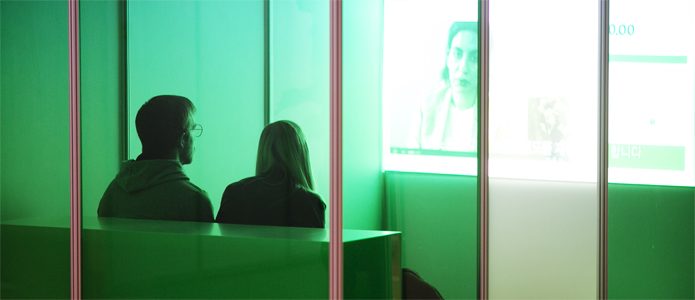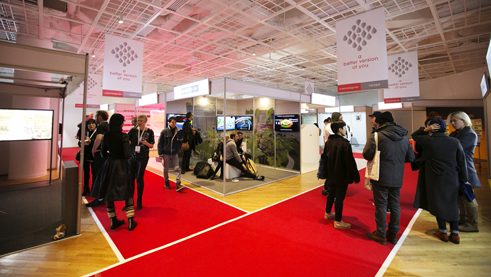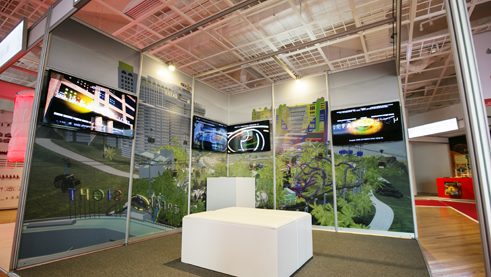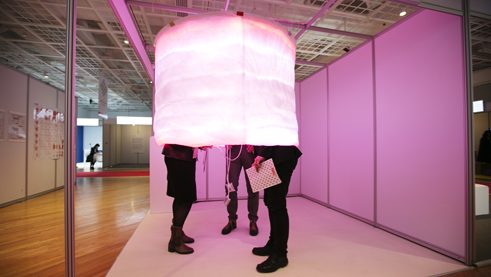Exhibition: A Better Version of You
Would you take my job, Alexa?

Artists laud products of a brave, new world that does not even exist. The boundaries are blurring between business, technology and art. In Seoul, the exhibition by the Goethe-Institut "A Better Version of You" questions the social and political consequences of artificial intelligence and scientific progress.
By Liu Chuchu
Last year, the upgrade version of AlphaGo Master beat Ke Jie. From now on, no human Go player will be able to succeed in defeating Artificial Intelligence (AI). According to a recent study by McKinsey, one third of the US workforce will have to change careers over the next ten years due to the use of artificial intelligence. So what consequences will there be when science and technology develop in this direction?
If it’s all so much fun…
This question was at the beginning of A Better Version of You, an exhibition presented by the Goethe-Institut with the Art Sonje Center in Seoul. When I entered the museum, I first had the impression that I was in the wrong place. Unlike the media art exhibitions that have been so popular in recent years and showcase a variety of unusual, cool effects, each exhibit here is very “clean” and contains virtually no art. Each of the exhibition kiosks, which are designed like trade fair stands, displays the name of a technological enterprise. Atmosphere like at a trade fair: At the individual stands, the works of art are exhibited like real-life technologies.
| Photo: Yunsik Lim/Goethe-Institut
The artists wear Western clothing like that normally worn by businesspeople, and inquire quite seriously about the purchasing intentions of the visitors to then promote a technological product that does not exist. One has to study the descriptions of the products very carefully in order to be able to decode their hidden meaning. In this way, we learn how science and technology alienate us in seemingly harmless ways, step by step of our lives.
Atmosphere like at a trade fair: At the individual stands, the works of art are exhibited like real-life technologies.
| Photo: Yunsik Lim/Goethe-Institut
The artists wear Western clothing like that normally worn by businesspeople, and inquire quite seriously about the purchasing intentions of the visitors to then promote a technological product that does not exist. One has to study the descriptions of the products very carefully in order to be able to decode their hidden meaning. In this way, we learn how science and technology alienate us in seemingly harmless ways, step by step of our lives.
…who needs a healthy work-life balance?
For example, the Playstation project developed by the fictional technology company Farsight in 2037 uses more than 160 brain scanners. All you have to do is put on a Mandala-like VR headset and you find yourself in a virtual world. The project claims “to be able to provide the elites with a reliable, full-brain simulation so that they can make new friends and develop their superstar ability on their promotion.” It not only can help one to be free of work, but also entertains – after all, there is also a casino theme park in here. “If it’s all so much fun, who needs a healthy work-life balance?” “Play Station™ - Farsight” by Lawrence Lek is a VR experience that rewards elites.
| Photo: Yunsik Lim/Goethe-Institut
“Play Station™ - Farsight” by Lawrence Lek is a VR experience that rewards elites.
| Photo: Yunsik Lim/Goethe-Institut
Brave New World?
“We are a company from Dubai and help you to implant a chip in your brain. We want to harness the potential of humanity, increase your social competitiveness and generate the new resources that come from the human-machine relationship.” Du Yuqing presents a business card identifying him as a “manager” while demonstrating the “chip” on his body. “With this chip, by the time you are ten years old, you can learn everything you would not learn until university. This can dramatically increase people’s work efficiency.”Du Yuqing believes that the future of technology will mainly expose us to extreme controls that no one will be able to escape. His work reminds me of Aldous Huxley’s novel Brave New World. And this brave new world is frightening.
The unholy trinity of hardware, software and wetware
The German media scholar Friedrich Kittler once wrote: “The world in which we have been living for forty years is no longer classified in rocks, plants and animals, but in the unholy trinity of hardware, software and wetware.” In every epoch, artists make use of their present context and available materials to reflect their time. “SWARM” by Metasitu is social software that visualises the collective consciousness.
| Photo: Yunsik Lim/Goethe-Institut
“Kittler’s thinking forms the theoretical basis of this exhibition,” say the curators Christian von Borries and Nina Franz. More and more artists are using scientific and technological methods in their work, blurring the boundaries between business, technology and actual art. The curators want to play with these “mixed feelings” and exhibit the artwork using technological formats. “We try to distance ourselves from commonplace beliefs such as the notion that AI will eradicate humankind,” emphasise Borries and Franz. Instead, we are shown how digital art enables artists to create new narrative forms in which approval and critique exist side by side.
“SWARM” by Metasitu is social software that visualises the collective consciousness.
| Photo: Yunsik Lim/Goethe-Institut
“Kittler’s thinking forms the theoretical basis of this exhibition,” say the curators Christian von Borries and Nina Franz. More and more artists are using scientific and technological methods in their work, blurring the boundaries between business, technology and actual art. The curators want to play with these “mixed feelings” and exhibit the artwork using technological formats. “We try to distance ourselves from commonplace beliefs such as the notion that AI will eradicate humankind,” emphasise Borries and Franz. Instead, we are shown how digital art enables artists to create new narrative forms in which approval and critique exist side by side.The article by Liu Chuchu is a shortended version. It was published in full length in the Chinese online magazine LENS.
Comments
Comment